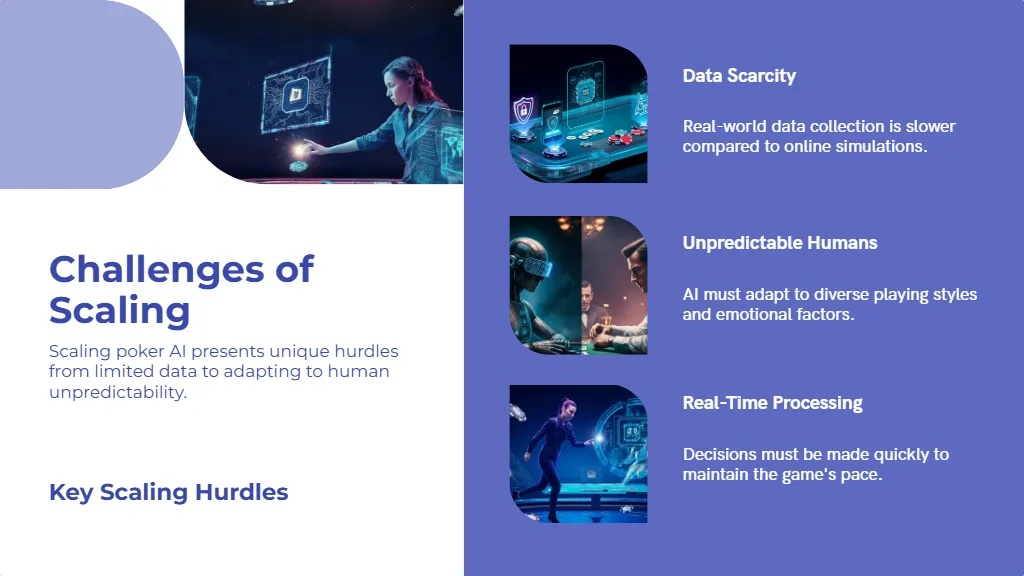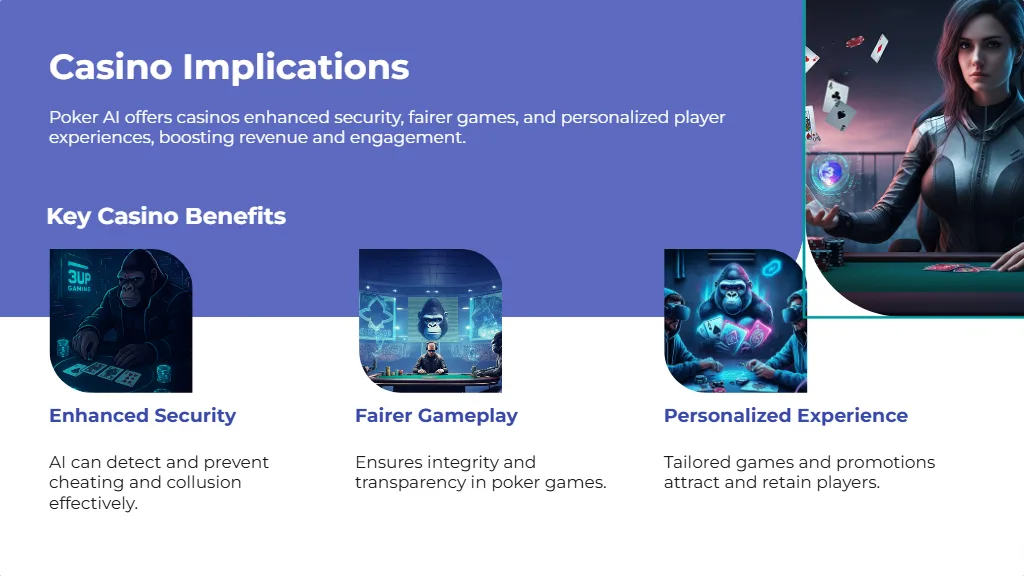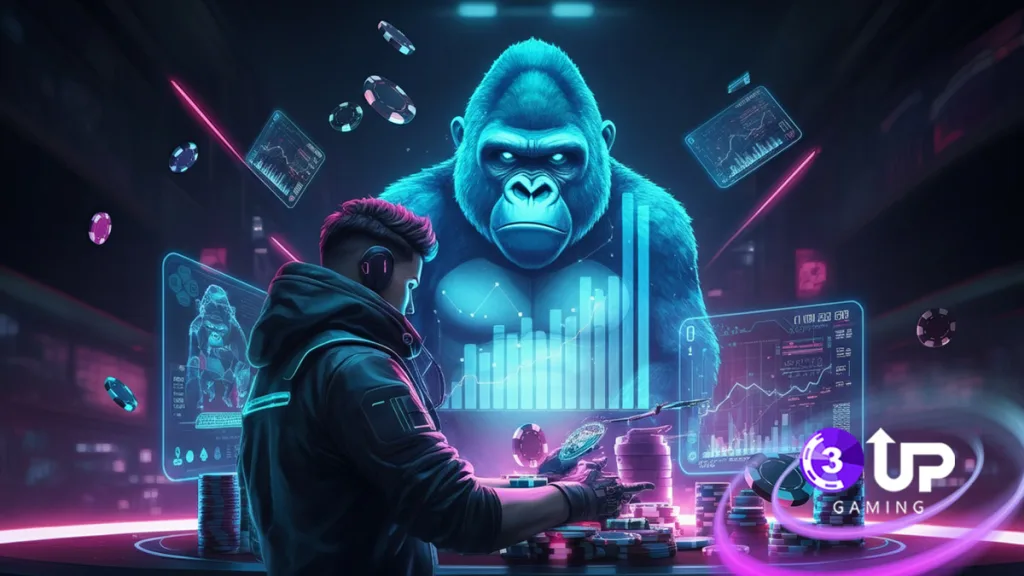From Club to Casino: Scaling Poker AI for Real Rooms! The neon lights of Las Vegas did not start Poker AI. It started in back-room and secret clubs where hobby code-writers had written trivial poker playing bots to churn the micro-bets on the Internet. What had started out as rough scripts became complex solvers for GTOs that revolutionized web strategy, and even how live amateurs played the felt? The revolution of digital-first was merely the warming-up show.
Introduction: Poker A.I., How it began as a Small Club and then a Large Casino
Now, the conversation has shifted: how do you bring poker AI in casinos without breaking the essence of the game? The shift from the pure online world to the hybrid play of chips that are completely controlled by cameras, sensors, and decision engines is not merely something new. It’s about scale. It means providing casinos with the same data advantage online platforms had over the last ten years.
AI cannot be a side of casinos. AI poker real room systems are already being prototyped, and the ones that succeed will set the tone for the next era of competitive play.
The shift of AI to the real world still does not imply the replacement of the game but rather an enhancement of the latter.
Real-Room poker environments: How to learn to overcome the challenges of the real-room environment

Stock prices and player betting records are clean input. But real rooms? That’s a different beast. Chips could be banging, people could be moving in their seats, dealers can be controlling the speed and each table possibly slightly different equipment. This complexity makes scaling poker AI from online models into the casino floor one of the toughest leaps in gaming tech.
Treading administrative minefields
The example of an African casino that secretly tested cameras on poker tables with AI control may be considered. It worked very well in tracking the movement of chips, but it did not work well with tracking chips stacked in unusual ways and in cases where the cameras were distracted by lighting. It’s a reminder: live poker AI bots can’t assume ideal lab conditions.
Then there’s regulation. What is accepted in one part of the world would be rejected entirely in another part. Layers of compliance between AML checks and fairness audits and anti-collusion standards create far more than math. They demand trust.
What developers need to understand is that real room poker AI is not a program export. It is an adaptation to an analog world, to human ways and fancies, to the ground.
The developers should be capable of thinking chipsets, felt, but not pixels.
The significant technologies of scalable poker AI
Scaling poker AI into casinos isn’t about one breakthrough. It involves introducing the subjects to an ecological balance. At the core sits poker AI technology: machine learning models trained on billions of hands, decision trees optimized for variance, and neural nets tuned to spot deviations. However, that is just one half.
Casinos are superimposing to be employed in live settings:
- Computer vision: Reading cards in stacks, placing cards and even hand gestures.
- Predictive analytics: betting line prediction in different table games
- NLP interfaces: via this, AI can read dealer telephone conversations and player chats in real-time.
- IoT sensors: RFID and table devices are installed to capture every activity.
- Combined RTA controls: Advice controlling like the previous one but instead of interrupting the live play, the advice augments the play.
And 3UP Gaming is no exception. Casinos are not reinventing anything by utilizing the Cross-Platform Client Software and In-Platform Poker Bots, they are simply improving the model that has been tested in the sphere of online poker already. Connect it to fraud detectors and administration interfaces, and the artificial intelligence is no longer playing. It’s managing.
The AI assisted poker bots cannot crack the puzzle on its own. Pure math-based solvers can not either. It takes convergence (e.g., AI models, hardware integration, and operational systems working in sync), to make AI decision making poker scalable on the casino floor.
AI in casinos is not yet tech convergent.
Want more? Read: White Label Gaming Platforms and Providers Complete Guide.
AI Decision-Making: Low-Stakes to High-Stakes Tables

A one dollar/two dollar grinder and a one thousand dollar/two thousand dollar high roller inhabit different worlds. Low stakes are ragged: many limps, numerous multi-way pots, and wild wavy action. Prestige stakes are cut-throat, with each bluff and time tell matter costing six figures. In case of AI, it would be a requirement that the decision models are scalable.
At the low end, AI decision making poker thrives on volume. The bot consuming thousands of small pots, detecting recurring leaks and optimizing over time. In high-stakes, the model changes: fewer hands, but more precise, with bluff-catching and range-balancing taken to higher levels: That is not a go in theory, but this is precisely what testing casino bot is studying to do.
To the operators, it is quite a clear-cut. Poker AI in casinos isn’t “one size fits all.” The AI should be adjusted to the betting, players blend, and even a culture of playing within the casino.
The mix of stakes in casinos requires a different configuration of AI.
Read more: Start Your Casino Online using White Label Casino Software.
The combination of Poker Bots and Casino Management Systems
In online poker, bots are treated as individual players. Nevertheless, the silo is ineffective at the casino floor. The real opportunity lies in casino poker bot integration, linking AI directly to the systems that run the room. The latter suggests that table monitoring, loyalty programs, rake distributions, and security dashboard know one another.
AI-supported Casino Optimization
Enhance the picture of a wiser casino CRM. Instead of just following the footsteps of a gamer playing a particular game and monetizing a player and comp, AI can track the trends in betting, how often a particular gambler is playing, and even hot spots of a table. When combined with poker AI technology, that information powers better rewards, fairer seating, and smarter resource allocation.
The Advanced Back-Office and Admin Dashboard that 3UP Gaming already offers is already capable of this connective tissue allowing the operators to see all this in real-time. Combine Configurable Rake & Rewards Economy and before long, poker AI is not only taking moves at the felt, but is also in charge of how the business is run.
The distinction between an AI being placed next to a casino and one residing within it is its integration. This is where efficiency is achieved, player loyalty, and growth in the revenue actually lifts off.
It should not be kept outside, but it must be part of the heartbeat of the casino.
Choosing the right platform? Go there: Best UK Poker Sites 2025: UK Online Poker Rooms.
Live Poker Room Data Collection and Analysis
Ask any casino operator what they could use more of and the answer is clear constant reliable data. Online websites assume that; each click, bet, and timing is recorded. But live rooms have lagged behind, and that’s exactly where poker AI data analysis is changing the game.
Reading of the modern systems depends on a network of inputs:
- RFID tags used to place bets of chip size.
- Tracking camera shots on gestures, card placement and calls of the dealer.
- Action-synchronizing dealer logs.
- Sensors that identify suspicious actions of the players.
Together, these sources give live poker AI bots the clarity they need to function like their online counterparts. This approach was tested as a pilot project in Macau in which tables were equipped with RFID-enabled chips and Artificial Intelligence vision. The results? Almost flawless tracking pots and a significant reduction in dealers disputes.
What is more important is what casinos can do with this information. Long-term patterns are put into the focus of the batch analysis: which tables are most actively in use, where are most losses, how loyalty bonuses affect retention. In its turn, real-time analysis streamlines into fraud prevention, real-time rake adjustments, and enhanced player experience.
In order to support this backbone, 3UP Gaming offers AI-based Fraud Prevention and Anti-Bot Measures that would guarantee the safety of the data gathered by the house and players themselves.
The more advanced the data is, the more advanced the AI advantage.
Next: The Right Software to Launch Your iGaming Business.
Securities, Fairness, and Regulatory Compliance

The use of AI in casinos provokes the following question: are gamblers confident in it? Regulators are also posing the same question. Legal considerations of poker AI aren’t theoretical; they’re the bottleneck between innovation and adoption.
The first challenge is transparency. If a poker AI in casinos tracks data, players and regulators want assurance it isn’t tilting outcomes or breaching privacy laws. That is, complying with GDPR in Europe, AML in Asia and KYC laws everywhere. Violators of these layers will be fined but more than that their reputation will be at risk.
AI poker monitoring Pilot regulatory Insights
A micro-story makes the case: Nevada’s regulatory board recently greenlit a controlled trial of AI-assisted poker monitoring. The pilot demonstrated increased accuracy in hand-tracking, but the regulators demanded that every decision by AI be auditable. That shaped what compliance-first will mean in the future.
That is how 3UP Gaming designs. Integrated RTA controls keep the outputs of AI within the legal limits, and Multi-Currency & Cryptocurrency Wallet Integration maintains the transparency and guidelines of financial flows across countries.
Equity is not an amenity of poker, it is life. When players believe that the system is unfair, they quit. Where regulators have the suspicion of bias, they close the doors.
When this is not complied with, AI scaling kills in the lobby.
What is coming next: Different Types of Poker Games Explained – Complete Guide (2025)
Case Studies: AI in Casinos: Successes of Implementation

Theory is interesting. Proof is what matters. And while most headlines focus on online AI, there are underreported success stories of poker AI technology already thriving in live casinos.
South America in a medium-sized market. The developers have partnered with one of the casino chains in testing poker rooms, which run on artificial intelligences. AI based fraud detection first and profile of player loyalty last, the plan was implemented in stages on the one hand RFID chip based first. Parent property realized 9 percent rake efficiency increase and 15 percent player retention in 6 months. The decision among the players also led to more trust since the size of the pots that are fought by the AI was also reduced significantly due to the accurate tracking of the hands by the artificial intelligence.
Case Studies: AI-Implementation in Casinos and its Success
Theory is interesting. Proof is what matters. And as most headlines will focus on online AI, there are already unreported AI technology successes in poker playing where it is thriving in live casinos.
The big wins of Pilot Project South America
- Slow adoption of AI: RFID tags-to-fraud-to-reward profile.
- greater of the efficiency of rakes 9, greater of the retention of players 15.
- Better AI hand tracking of the player.
- Solutions to modular intelligence systems.
For tech investors, these pilots demonstrate that poker AI in casinos is not only feasible but lucrative. It does not have to be invented by the operators but rather implemented to make use of Stable and compliant and modular platforms.
Want smarter decisions? Read: How to play Omaha poker game beginner to pro.
Dev lessons: Training AI to play in the wild
Internet code does not expand to the room itself. This was the single biggest myth in scaling Poker AI as developers assumed that designs trained and fine-tuned on clean data on the Internet would operate the same when applied to a full table in a land based casino.
Here are some tips that you have to remember when you write it:
- Create blockchain AI which can grow.
- Live dealer test: discover the flaws sooner.
- Keep your architecture before construction.
Code the room, not a bot Your bots will be coded, no room will ever code. How does that sound?
Further reading: How to win more at poker: Human vs. Artificial Intelligence robot.
AI at Poker: The Destiny of Bricks and Mortar Gambling

Poker AI likely to extend far past table tracking in next 10 years Think about that: a VR poker room, where you can have heads on to sit across from the AI play able opponents, or the dealers in adjacent rooms and hands-on instruction to teach accuracy and timing. Not far-fetched sci-fi ideas, they’re already on the drawing boards of inventors in casinos.
To the operators, the visual layer is huge. Imagine NFT table skins that personalize a poker room and blockchain-verify ownership. Add that NFT-Based Poker Characters and Smart-Contract Assets, and soon enough players won’t be sitting at a table: they’ll be investing in unique, tradable identity-based experiences.
That’s what poker AI really means going forward; not just optimizing hands, but crafting ecosystems. And to regulators it’s also transparent enough: blockchains and AI logs are uncheatable ledgers.
By 2030, anticipate future of poker AI casinos to resemble less a table of tables and more a playground where human strategy, algorithmic accuracy, and tokens intersect.
The 2030 casino not only will have players, but will play with them.
In-depth: The Ultimate guide to starting a Turnkey iGaming Business.
FAQ: From Club to Casino, Scaling Poker AI for Real Rooms
- Can poker AI be used in real casino rooms?
Yes. Sure, you need to treat poker AI and automate live decisions, as the sector is still regulated, but you can toxify it for running casinos indirectly by mining data and training systems and enhancing the player experience. - The difference between online and live poker?
Physical poker relies on human behavior, live poker reads and poker psychology, whereas the digital kind depends on digital data and automation – the former, of course, are more difficult to emulate with AI. - Why poker AI can’t scale to casinos?
Challenges also include live capture of data, privacy compliance, use of ethic AI and alignment to the unexplainable live player behaviors. - Is poker AI street legal in a brick-and-mortar?
It depends on the state and the application. Analytics and training is ok, but in-game decisions are restricted or banned in most casinos. - What are the RL conditions under which AI analyzes opponents?
AI can bet, predict behavior and gestures by looking at computer visuals of gambling, tracking and other trends to come up with ideas. - Can AI increase the income and efficiency of casino?
Yes. Tables, security, player engagement, game fairness and efficiency, and eventually casinos profitability can be managed by AI.
- What of poker intelligence in the casinos?
Hybridized models, intelligent coaching, detection of unfair play, and progressive statistics like a smooth combination of intuition and algorithm accuracy are the way forward.



